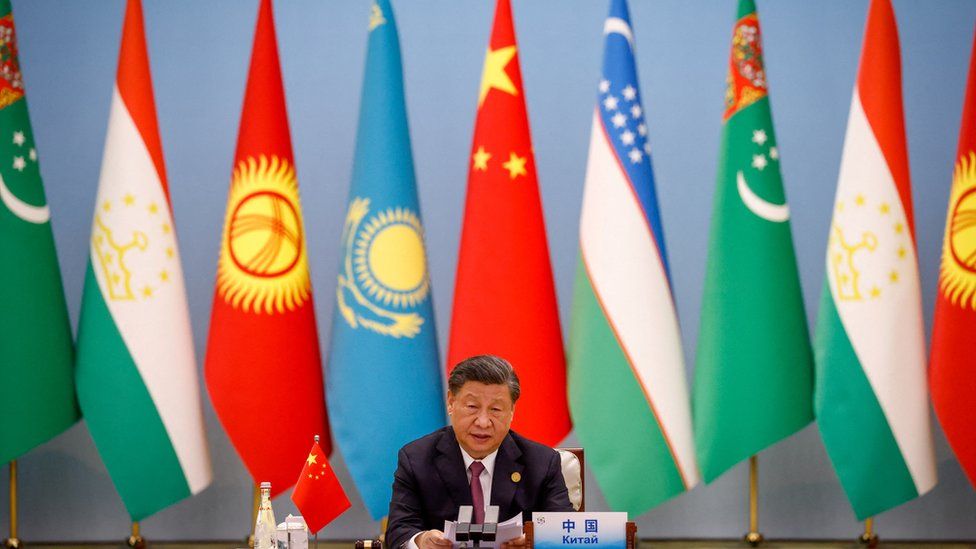As the G7 leaders sent a strong message to Russia by inviting Volodymyr Zelensky to Hiroshima, another rival was also on their minds – China.
British Prime Minister Rishi Sunak said China posed “the greatest challenge of our age” in regards to global security and prosperity, and that it was “increasingly authoritarian at home and abroad”.
And in not one but two statements, the leaders of the world’s richest democracies made clear to Beijing their stance on divisive issues such as the Indo-Pacific and Taiwan. But the most important part of their message centred on what they called “economic coercion”.
It’s a tricky balancing act for the G7. Through trade their economies have become inextricably dependent on China, but competition with Beijing has increased and they disagree on many issues including human rights.
Now, they worry they are being held hostage.
In recent years, Beijing has been unafraid to slap trade sanctions on countries that have displeased them. This includes South Korea, when Seoul installed a US missile defence system, and Australia during a recent period of chilly relations.
The European Union was particularly alarmed when China blocked Lithuanian exports after the Baltic country allowed Taiwan to set up a de facto embassy there.
So it is unsurprising that the G7 would condemn what they see as a “disturbing rise” of the “weaponisation of economic vulnerabilities”.
This coercion, they said, seeks to “undermine the foreign and domestic policies and positions of G7 members as well as partners around the world”.
They called for “de-risking”- a policy that Ms von der Leyen, who is attending the summit, has championed. This is a more moderate version of the US’ idea of “decoupling” from China, where they would talk tougher in diplomacy, diversify trade sources, and protect trade and technology.
They have also launched a “coordination platform” to counter the coercion and work with emerging economies. While it’s still vague on how this would work exactly, we’re likely to see countries helping each other out by increasing trade or funding to work around any blockages put up by China.
The G7 also plans to strengthen supply chains for important goods such as minerals and semiconductors, and beef up digital infrastructure to prevent hacking and stealing of technology.
But the biggest stick they plan to wield is multilateral export controls. This means working together to ensure their technologies, particularly those used in military and intelligence, don’t end up in the hands of “malicious actors” .
- Taiwan looms large as Japan prepares to host G7
- Zelensky dominates summit as G7 leaders call out China
- Japan’s 75-year pacifism hangs in balance as new threats loom
The US is already doing this with its ban on exports of chips and chip technology to China, which Japan and the Netherlands have joined. The G7 is making clear such efforts would not only continue, but ramp up, despite Beijing’s protestations.
They also said they would continue to crack down on the “inappropriate transfers” of technology shared through research activities. The US and many other countries have been concerned about industrial espionage and have jailed people accused of stealing tech secrets for China.
At the same time, the G7 leaders were clear they did not want to sever the cord.
Much of their language on economic coercion did not name China, in an apparent diplomatic attempt to not directly point a finger at Beijing.
When they did talk about China, they stood their ground in a nuanced way.
They sought to placate Beijing, saying their policies were “not designed to harm China nor do we seek to thwart China’s economic progress and development”. They were “not decoupling or turning inwards”.
But they also put pressure on the Chinese to cooperate, saying that a “growing China that plays by international rules would be of global interest”.
They also called for “candid” engagement where they could still express their concerns directly to China, signalling their willingness to keep communication lines open in a tense atmosphere.
We won’t know how, privately, Chinese leaders and diplomats will take the G7’s message. But state media in the past has hit back at the West for trying to have it both ways, by criticising China while also enjoying the fruits of their economic partnership.
For now Beijing has chosen to fall back on its usual angry rhetoric for its public response.

China had clearly anticipated the G7’s statements and in the days leading up to the summit, its state media and embassies put out pieces accusing the US of its own economic coercion and hypocrisy.
On Saturday evening, they accused the G7 of “smearing and attacking” China and lodged a complaint with summit organiser Japan.
They also urged the other G7 countries not to become the US’ “accomplice in economic coercion”, and called on them to “stop ganging up to form exclusive blocs” and “containing and bludgeoning other countries”.
It is worth noting that China has also sought to create its own alliances with other countries, and late last week just as the G7 summit kicked off, it hosted a parallel meeting with Central Asian countries.
It’s still not clear if the G7’s plan will work. But it is likely to be welcomed by those who have called for a clear strategy to handle China’s encroachments.
Indo-Pacific and China expert Andrew Small praised the statement as having “the feel of a real consensus”, noting that it expressed the “centre-ground” view of the G7.
“There are still major debates playing out around what ‘de-risking’ actually means, how far some of the sensitive technology export restrictions should go, and what sort of collective measures need to be taken against economic coercion,” said Dr Small, a senior transatlantic fellow with the German Marshall Fund think tank.
“But there is now a clear and explicit framing around how the economic relationships with China among the advanced industrial economies need to be rebalanced.”